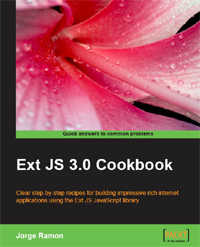For those who don’t know, Ext JS is a JavaScript library aimed at helping developers create web applications with customizable user interface widgets. The library is known being sturdy and for letting users easily create eye-catching designs. However, unlike many other JavaScript libraries, Ext JS is licensed under the GPL by default. For people wanting to avoid the GPL, a commercial license can be purchased.
Ext JS 3.0 Cookbook is a book which has the goal of providing Ext JS users with a wide variety of techniques and code samples with which they can use in their development of web applications. The book is well written, has nicely formatted code samples (which are also available in a zip file – a URL to the file is given in the book), and contains a lot of interesting information. However, I wouldn’t recommend it to everyone, which I’ll get to in a moment.
Ext JS 3.0 Cookbook is divided into 10 chapters, with each chapter covering a different topic of the library. However, the book can really be thought of as one giant, categorized, FAQ guide on Ext JS. Each chapter contains a series of “recipes”. These recipes are specific tasks a developer might want to perform, for example: “Displaying remote data with a combo box” or “Creating a grid panel with expandable rows” or “Creating an auto-refreshing chart”.
The definition of each recipe follows a set pattern of 5 sections:
- The problem is described.
- “How to do it…” – Code for solving the problem is provided.
- “How it works…” – An explanation is given on how the code works.
- “There’s more…” – Additional, possibly useful, bits of information are provided.
- “See also…” – Other topics are suggested as further reading.
Each of these sections is given its own heading, though some recipes omit a section when it isn’t needed. This makes the book well suited as a reference guide since you know what you’ll be getting when you look something up. However, even though the book starts off with some recipes on working with the DOM and with data types, it’s not a book for Ext JS beginners. If you’re a new comer to Ext JS, you’re better suited by a book like Learning Ext JS.
Ext JS 3.0 Cookbook is really for those Ext JS users who are past the beginner stage and want something on-hand that will help them accomplish tasks they may run into or help them find better solutions to problems they’ve already had. If you work with the Ext JS library as part of your job or use the library a lot, having this book around would probably be beneficial. It’s nicely put together and has a lot of useful information. However, if you’re just a casual user of the Ext JS library, you’d probably find more benefit from an introductory text on the library or from just browsing their online documentation.
